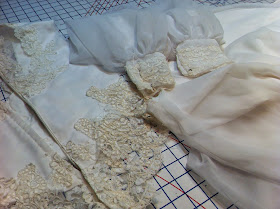This dress was the brides mother's wedding gown some 30-40 years ago, and what mother doesn't want to see their daughter married in the same dress? It was my job to alter this for another day at the Alter, and I needed to add about 5" more to the bodice width and enlarge the sleeves which were too tight. I was to maintain the integrity of the design as much as possible.
Enlarging isn't a problem as long as you have access to more of the same fabric. Purchasing anything to "match" in terms of color, fabric, style, dye, pattern, wear, age, or type is right there next to impossible. If that thought ever crosses your mind, just wipe it clean now. In this case, my extra yardage would be coming from an extra long train that was to come off.
The first thing I did was take careful and thorough measurements. There were to be no fittings during this process, (which I don't recommend - it's like driving a car blind) so with scrap fabric, I draped a bodice on my girl. It would be my "map" of her figure.
Once I was ready to begin, I first took the dress sections apart:
My plan included a princess seam at the front (the dress has only one bust dart from the waist) to add more bust shaping and increase the width. Using the bodice drape, I determined the shape of the front and side front, and where the seam would go.
Then I pinned the paper pattern to the bodice to measure it and check it against the body measurements I had taken earlier. I also also experimented with some possible options for replacing the lace at the waist.
Before determining the hem, I cut all the pieces from the bottom of the train and sewed the bodice together.
For the skirt, I determined the diameter mathematically (being a circle skirt), then I sewed a basting stitch at that point, about 2" from the raw edge, to keep the layers together. Then I trimmed away leaving a seam allowance.
With everything together, I put the dress on a mannequin and very carefully cut the skirt hem all the way around. On a circular hem, I always cut it longer than I think I want, then go around again leveling it one more time. This hem was sewn using a serged rolled hem. It's the only way to hem chiffon!
The original sleeves had a lace insert that I needed to add to the larger sleeve. To do that, I cut the fabric close to the stitching and pulled the fabric loose, leaving the stitching alone. The new sleeve had to fit into the small cuff, so it was tapered to fit.
On the back, rather than adding in a princess line in the usual spot, I just added a panel to the original side seam. I also added a dart in the back, which it didn't originally come with, to help this bodice fit better than it would otherwise. Eliminating darts is a shortcut for smaller sizes that would never look good on larger people. We need those to fit our curves!
I did want to keep the back "ruffle" so I shaped the lace, curving the ends up to finish the edge and decided that it looked fine as a little "peplum" in the back.

Shaping the back allowed me to take a little lace to fill in the front over those double seams (the original dart and the new princess seam) and give it a natural look. I wish there had been enough lace to fill in the sides, but it still looks nice.
In working with these beaded laces, you might not know that you can sew it all by machine using a darning foot. It has a little spring on it so you can move the dress around as you sew, avoiding the beads and following the shape of the lace. To glue the beads back on that inevitably fall off, put a little glue on a disposable surface and let it sit there until it gets old and tacky and almost dry in some places. Using a pin through the bead hole, pick up your bead, tap it in the glue, then apply to the dress. It will hold much better to the dress. Holds fast, dries quickly. I like that.
And if you want to learn how to resize various areas or even a whole pattern, check out my Pattern Resizing Tutorials, Part 1: Small to Large or Part 2: Large to Small.










Wow. That is amazing how you managed to make it larger and still keep the integrity of he dress. It looks beautiful
ReplyDeleteClever work.
ReplyDeletevery helpful!
ReplyDeleteThanks!